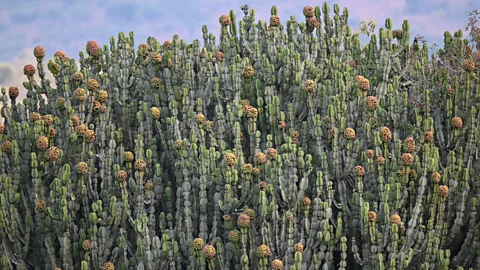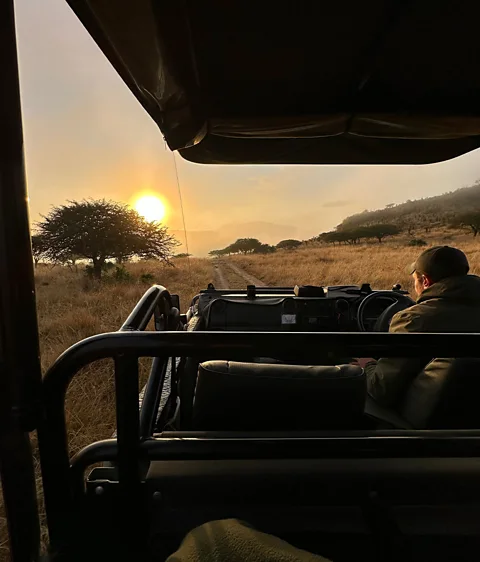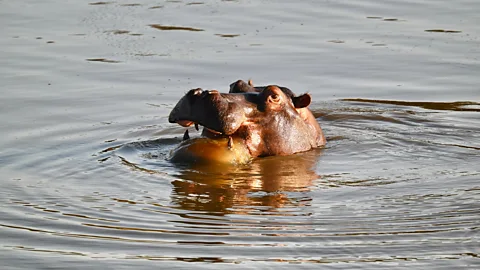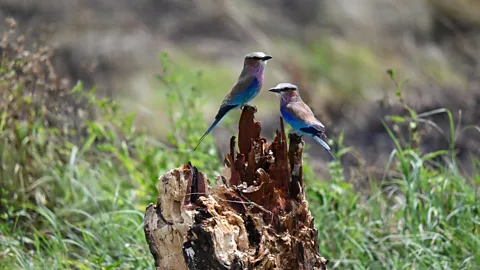South Africa's new 'Big Five' safari destination
 Felipe Bascunan
Felipe BascunanOnce emptied of wildlife, South Africa's Babanango Game Reserve is now home to the Big Five – thanks to a bold rewilding project led by Zulu communities and global conservationists.
Daybreak filters through the fever trees and umbrella thorns of South Africa's White Umfolozi River Valley, splintering orange light across a puckered grassland teeming with newly arrived wildlife. Bumping atop rough roads in an open-sided safari vehicle is field guide Eduan Balt, who's "reading the bush newspaper" – studying fresh prints on dirt trails for signs of apex predators.
Balt drives along some of the valley's 600km of roads – many built in recent years – passing bomas (enclosures) holding quarantined buffalo and a pond where hippos with giant jowls yawn into the morning air. The smell of wild anise wafts over the vehicle as it careens toward the valley floor. Then, suddenly, a lioness darts across the golden grassland to our left, muscling her way to a fallen tree where three kitten-like cubs bound into view.
These are the first lions born in this part of KwaZulu-Natal province in at least 150 years. Lions, like most native animals, became locally extinct in the decades following the Anglo-Zulu War of 1879, after which the British Empire gained control of the region, turning it into farmland. Zulu communities got large swathes of it back during the land reforms that followed the fall of apartheid. But after decades of cattle grazing and illicit hunting, the area was largely depleted of wildlife.
That changed starting in 2018, thanks to an innovative collaboration between philanthropic investors, local NGOs and three Zulu community trusts, who leased lands to create one of the most ambitious rewilding projects in South Africa in more than a decade. The 20,000-hectare Babanango Game Reserve has welcomed nearly 4,000 medium- to large-sized animals since the process of game translocation – and remediating landscapes – began, in earnest, five years ago. Many, like the lions, have reproduced. So, there are now about 5,000 wild animals roaming a landscape they were largely absent from for more than a century.
 Mark Johanson
Mark JohansonGerman philanthropists Barbara and Hellmuth Weisser invested nearly 1 billion rand (£42.5m) to rewild these animals. They also bankrolled the tourist infrastructure that should support Babanango's future operational costs. "I don't know of anyone else doing something quite like this," Hellmuth tells me over dinner at the Zulu Rock Lodge, one of four safari lodges now spread across the park.
The 77-year-old – a former energy executive and keen photographer – has been visiting southern Africa since the 1980s. In retirement, he and his wife wanted to find a place for a park that would uplift communities while restoring biodiversity. "The problem for us is that there was no supermarket for finding projects," he recalls.
Babanango is south of Kruger National Park in a poorer region of South Africa closer to Durban than Johannesburg that wasn't historically a safari destination. It appeared on Hellmuth's radar only because the NGO Conservation Outcomes had identified a community trust, Emcakwini, looking for a partner to lease its unpopulated lands.
Hellmuth visited Babanango in 2017 and says he fell in love with its wild topography, including the boulder-strewn hills that tumble down 700m from our hilltop perch at Zulu Rock. "We didn't want to buy somewhere where there was an existing project that had been run into the ground," he recalls. "When we got here, we found a landscape that was extremely interesting."
In 2018, the Weissers signed a contract with the Emcakwini Community Trust. Two smaller neighbouring trusts, Esibongweni and Kwa Ngono, came onboard in 2019 and 2020 respectively. All told, about three-fourths of the game reserve is now leased from these communities, who earn a rental fee and share ownership of the animals. The community trusts will also receive 25% of park profits when the project becomes solvent.
 Mark Johanson
Mark JohansonBabanango transformed into a Big Five game reserve in record time, but the process was not without its challenges. First, there was the 2,600 cows, 300 goats and 35 donkeys that the community trusts promised to remove from the land; something that didn't happen for more than three years. Then, in 2022, finally free of livestock, the park could complete its 81km perimeter fence, though much of what was initially laid was cut by ranchers and poachers. A majority of the wild animals arrived beginning in late 2022.
Plan your trip:
When to go: There's no bad time to visit. Summers (Sep to Apr) are hot and humid, while winters (May to Aug) are dry and cold.
How to get there: The park is a three-hour drive from Durban International Airport or a six-hour drive from Johannesburg's OR Tambo International Airport.
Where to stay: Babanango has four lodging options ranging from the rustic Matatane Camp to the luxurious Madwaleni River Lodge. Book directly for special packages and rates.
What to do: Beyond the daily safari drives, Babanango also offers guided bush walks, wildlife monitoring and battlefield tours.
"It was very important, becoming a nature reserve, that we have species that were endemic to the area," explains Chris Galliers, conservation manager at Conservation Outcomes, which consulted on the project. "A number of species were completely removed from the system; others like kudu, bushbucks and warthogs were still there in low numbers, but we needed to top them up for genetic purposes."
A few leopards roamed the land, too. Yet, rhinos, buffalo and lions were all reintroduced between May 2022 and March 2023. Elephants were the last of the Big Five to arrive in June 2023. "It was a big milestone," says Galliers. "It symbolised that everything we had to do to get to that point had been done correctly."
All rewilded animals live in bomas for several months before release to control for diseases such as foot-and-mouth. Most come from similar habitats to ensure they'll adapt and climatise as quickly as possible. There's also intense monitoring to ensure the balance of predator and prey remains intact. Efforts to discourage poaching include dehorning the rhinos (a procedure that conservationists use to increase the species' survival rates), which I spot my third day at Babanango behind fanning candelabra trees.
 Felipe Bascunan
Felipe BascunanGalliers is the first to acknowledge that the park is a massive disrupter for the region. "People have, for a large part of the past 200 years, been trying to get rid of these animals because of the threats they posed," he says. "Now, the animals are sitting on their doorsteps again. So, it's quite a thing to try and understand."
On my fourth and final day, I travel beyond the fence line, past browned fields trampled by cattle, to the village of Denny Dalton. Here, I meet with Thina Nyathi, manager of the African Habitat Conservancy Foundation (AHC), a registered public benefit organisation that supports Babanango with its community development work.
More like this:
• Zimbabwe's stunning 80km safari train
• The African elephant in the room: Is there such a thing as guilt-free safari?
Nyathi, who was born in KwaZulu-Natal and is a native Zulu speaker, shows me one of the 17 solar-powered boreholes that AHC built to bring running water to neighbouring communities. She also tells me about AHC's efforts to remove invasive plants, such as black wattles, which suck up the region's groundwater. "We see the direct impact this has on water scarcity because there are streams that were not flowing that, all of the sudden, are flowing again," she explains.
The foundation works with communities within a 10km radius of Babanango's fence line on everything from conservation education to agricultural support. It also runs vocational training, including classes on ceramics and Zulu beadwork so that the lodges in Babanango can sell crafts that uplift local artisans. "It's about teaching someone to fish, and not just giving them the fish," Nyathi says. "Working together means we also understand what their challenges are and support them to get to a point where they no longer need our help."
 Mark Johanson
Mark JohansonAbout 75% of the staff at Babanango comes from the surrounding communities, and for many, it's their first salaried employment. Dudu Ngcobo, who works as part of the park's ecological restoration team, sent her two daughters to university, which for Nyathi demonstrates the ripple effects of higher-paying job opportunities.
The park hires locally for short-term projects, such as land rehabilitation, which helps build a greater understanding of the reserve's potential paybacks and long-term impact. The hope is that Babanango can become a kind a blueprint for other conservation areas on locally owned landscapes. "Done right, we are able to have quite a big benefit on the environment," Nyathi says, "but also the communities that surround it."
--
If you liked this story, sign up for The Essential List newsletter – a handpicked selection of features, videos and can't-miss news, delivered to your inbox twice a week.
